Glossary
Plant Care Library
T
Tacca Chantrieri Black

How to care for Tacca Chantrieri Black
Tacca Chantrieri Black should not be in a position to see the sun directly, although early morning or late evening sun is fine. Filtered sunlight through a sheer curtain is best and most homes are comprised primarily of indirect sunlight. The best spot for them is where they do not see the sun during the majority of the day but still get bright, indirect light.
Tacca Chantrieri Black will thrive in bright light, but also can tolerate medium light. A good medium-light place in your home would be in the middle of a room that has a regular size window. They can be placed anywhere between the middle of the room and the window. Remember that plants will grow based on how much light they receive.
Allow the top quarter of the soil to dry before watering Tacca Chantrieri Black again. This usually takes about 3 - 4 days in an average home environment. It will vary depending on the time of year, your environment and lighting conditions. Expect to water more often in brighter light and less often in lower light.
Tacca Chantrieri Black likes a high humidity environment, give them a mist daily or as often as possible. Alternatively, you can put them around a humidifier. Although they won't die if they don't receive enough humidity, their leaves may have some dry, crunchy, or yellow edges.
Fertilize Tacca Chantrieri Black every month during the growing season with a balanced liquid fertilizer diluted to half strength. During the winter, reduce fertilization as the plant's growth slows down. Remove any faded or dead flowers promptly to promote further blooming. Keep the plant in a warm environment and avoid exposure to drafts or temperatures below 60°F (15°C).
Tacca Chantrieri Black is moderately toxic and can cause some adverse reactions when ingested so it is best to not let your pets eat it, which we advise for all plants in general. The severity of the reaction will depend on how much of the plant is ingested but, if you know your pet typically does not eat your plants, this plant will be suitable for your home..
View PlantTerra Cotta Cactus Garden

How to care for Terra Cotta Cactus Garden
They enjoy some direct sun, but they'll also do well in bright, indirect light. It is best to place this plant somewhere where it will receive some nice morning sun, or a couple hours of afternoon sun, and then indirect light the rest of the day.
They will do best in bright light. A nice bright place inside your home would be on the window sill or a stool that is right next to a window, either with or without blinds, depending on if the plant can handle sun. Remember that plants will grow based on how much light they receive.
They like the soil to be completely dry before the next watering. That usually takes about 4 weeks in an average home environment. It will vary depending on the time of year, your environment and lighting conditions, but for them, it's always safer to underwater or water when you see signs of lack of water (i.e. wrinkly or soft leaves). Water a little more often in the warmer months.
Their humidity requirement is low, so do not mist them or put them in an enclosed terrarium.
They will tolerate lower light conditions, but thrive in sun, and need very little water. They would much rather be too dry than too wet. Think of desert when taking care of them. During winter, when the plant is dormant, reduce watering significantly.
This plant is moderately toxic and can cause some adverse reactions when ingested so it is best to not let your pets eat it, which we advise for all plants in general. The severity of the reaction will depend on how much of the plant is ingested but, if you know your pet typically does not eat your plants, this plant will be suitable for your home..
Learn MoreView PlantTiger Aloe
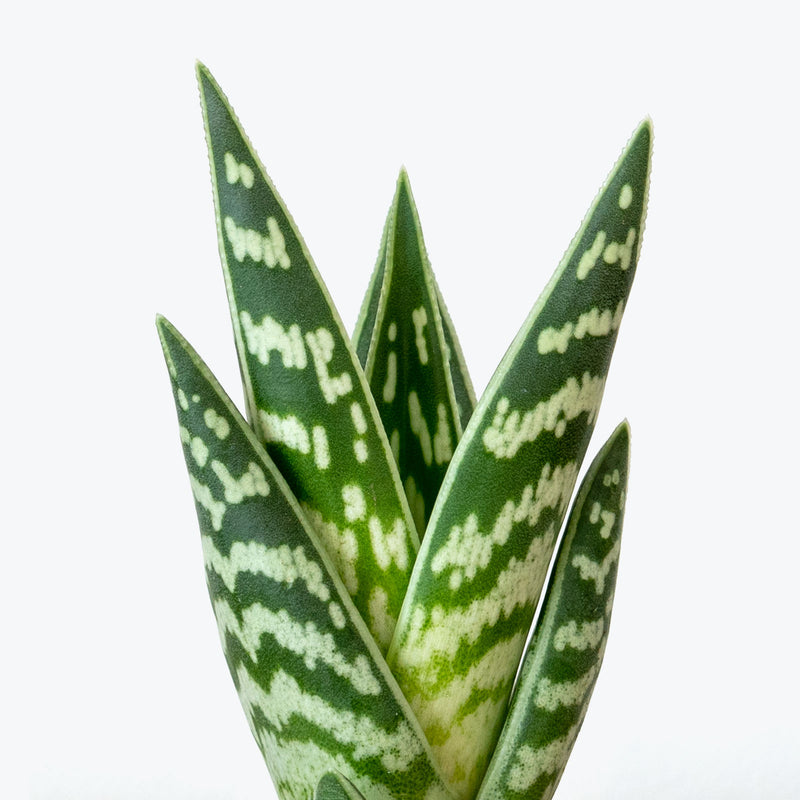
How to care for Tiger Aloe
Tiger Aloe enjoys some direct sun, but they'll also do well in bright, indirect light. It is best to place this plant somewhere where it will receive some nice morning sun, or a couple hours of afternoon sun, and then indirect light the rest of the day.
Tiger Aloe will do best in bright light. A nice bright place inside your home would be on the window sill or a stool that is right next to a window, either with or without blinds, depending on if the plant can handle the sun. Remember that plants will grow based on how much light they receive.
Tiger Aloe likes the soil to be completely dry before the next watering. This can take up to 4 weeks in an average home environment but it will vary depending on the time of year, your environment and lighting conditions. For them, it's always safer to underwater or water when you see signs of lack of water (i.e. wrinkly or soft leaves), and then water deeply. Water a little more often in the warmer months.
Their humidity requirement is low, so do not mist Tiger Aloe or put them in a terrarium.
Tiger Aloe is drought-tolerant and prefers to be under-watered. Not sure when to water? Wrinkles on the aloe’s fleshy leaves are a telltale sign. Avoid over-fertilizing to prevent harm to the plant. Repot every few years in the spring using a well-draining cactus or succulent potting mix to refresh the soil and provide adequate space for root growth.
Tiger Aloe is moderately toxic and can cause some adverse reactions when ingested so it is best to not let your pets eat it, which we advise for all plants in general. The severity of the reaction will depend on how much of the plant is ingested but, if you know your pet typically does not eat your plants, this plant will be suitable for your home..
Learn MoreView PlantTiger Jaws Succulent
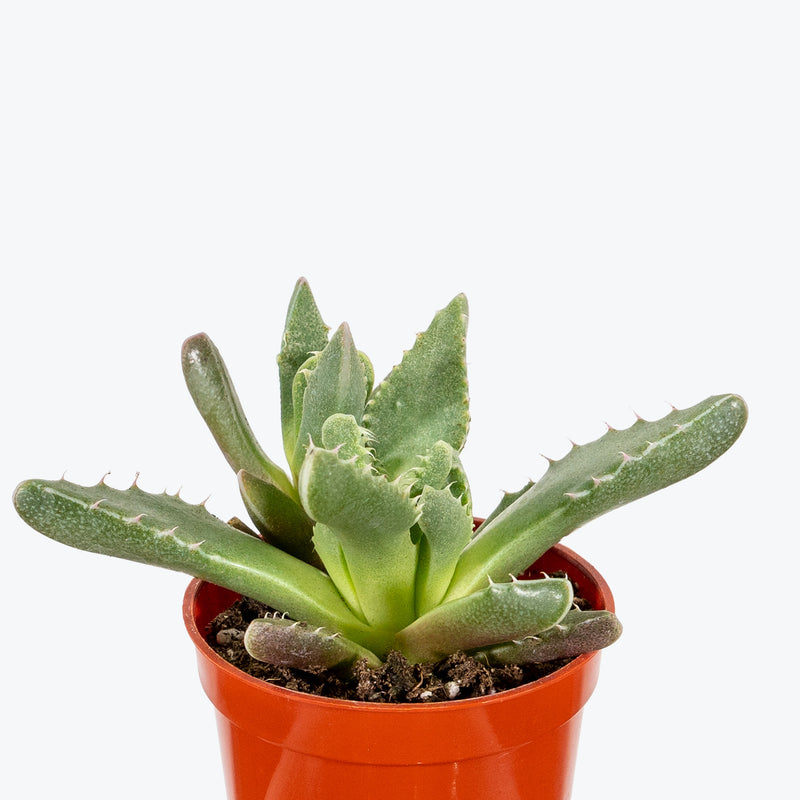
How to care for Tiger Jaws Succulent
They enjoy some direct sun, but they'll also do well in bright, indirect light. It is best to place this plant somewhere where it will receive some nice morning sun, or a couple hours of afternoon sun, and then indirect light the rest of the day.
They will do best in bright light. A nice bright place inside your home would be on the window sill or a stool that is right next to a window, either with or without blinds, depending on if the plant can handle sun. Remember that plants will grow based on how much light they receive.
They like the soil to be completely dry before the next watering. This can take up to 4 weeks in an average home environment but it will vary depending on the time of year, your environment and lighting conditions. For them, it's always safer to underwater or water when you see signs of lack of water (i.e. wrinkly or soft leaves). Water a little more often in the warmer months.
Their humidity requirement is low, so do not mist them or put them in a terrarium.
These succulents are sun-loving plants, so bring your outside once the days and nights start to warm up and place it in a nice, sunny location, but be sure to transition it so that the foliage does not burn. Placing your plant outdoors during the summer will help to increase the chances of flowering as well.
You can feel comfortable having this plant around your home in the potential case where your pet feels like nibbling on it. However, we typically recommend keeping your pets from eating any of your houseplants..
Learn MoreView PlantTillandsia Caput Medusae Air Plant
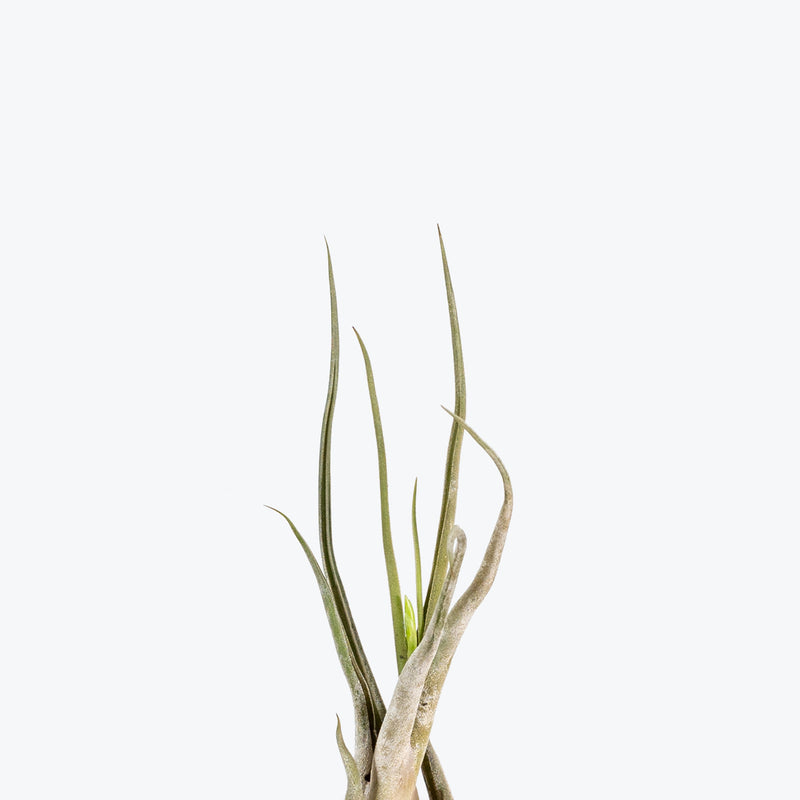
How to care for Tillandsia Caput Medusae Air Plant
Tillandsia Caput Medusae should not be in a position to see the sun directly, although early morning or late evening sun is fine. Filtered sunlight through a sheer curtain is best and most homes are comprised primarily of indirect sunlight. The best spot for them is where they do not see the sun during the majority of the day but still get bright, indirect light.
Tillandsia Caput Medusae will thrive in bright light, but also can tolerate medium light. A good medium-light place in your home would be in the middle of a room that has a regular size window. They can be placed anywhere between the middle of the room and the window. Remember that plants will grow based on how much light they receive.
Soak Tillandsia Caput Medusae in a bowl of room temperature water for an hour every week. Shake excess water off afterward and lay your plant upside down on a towel in a bright spot to dry.
Tillandsia Caput Medusae will do well in average humidity environments but will appreciate a little bit of humidity if provided, give them a mist daily or get a humidifier.
Provide good air circulation around the Tillandsia Caput Medusae Air Plant to promote healthy growth and prevent disease. Fertilize monthly during the growing season with a bromeliad or diluted general-purpose liquid fertilizer. During flowering, reduce watering and fertilization to support the bloom cycle. After flowering, the mother plant will gradually die back as it produces offsets, or "pups," which can be separated and grown as new plants.
You can feel comfortable having Tillandsia Caput Medusae around your home in the potential case where your pet feels like nibbling on it. However, we typically recommend keeping your pets from eating any of your houseplants..
Learn MoreView PlantTillandsia Curly Slim Air Plant
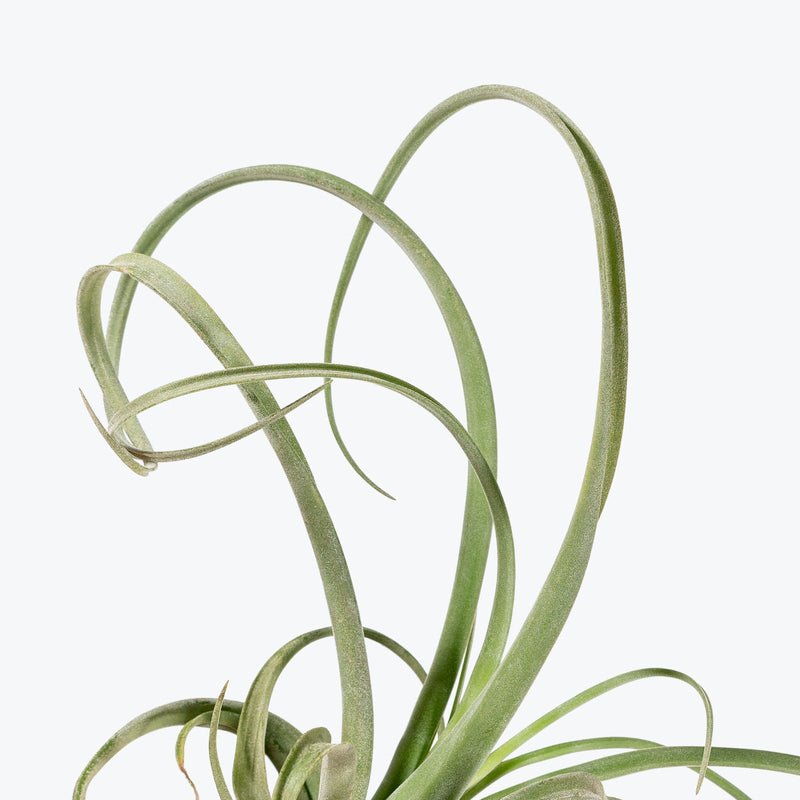
How to care for Tillandsia Curly Slim Air Plant
Tillandsia Curly Slim should not be in a position to see the sun directly, although early morning or late evening sun is fine. Filtered sunlight through a sheer curtain is best and most homes are comprised primarily of indirect sunlight. The best spot for them is where they do not see the sun during the majority of the day but still get bright, indirect light.
Tillandsia Curly Slim will thrive in bright light, but also can tolerate medium light. A good medium-light place in your home would be in the middle of a room that has a regular size window. They can be placed anywhere between the middle of the room and the window. Remember that plants will grow based on how much light they receive.
Soak Tillandsia Curly Slim in a bowl of room temperature water for an hour every week. Shake excess water off afterward and lay your plant upside down on a towel in a bright spot to dry.
Tillandsia Curly Slim will do well in average humidity environments but will appreciate a little bit of humidity if provided, give them a mist daily or get a humidifier.
Air circulation is crucial for the health of Tillandsia Curly Slim. Ensure it's placed in an area with good airflow. Fertilize monthly with a bromeliad or air plant-specific fertilizer to encourage growth and blooming.
You can feel comfortable having Tillandsia Curly Slim around your home in the potential case where your pet feels like nibbling on it. However, we typically recommend keeping your pets from eating any of your houseplants..
Learn MoreView PlantTillandsia Cyanea
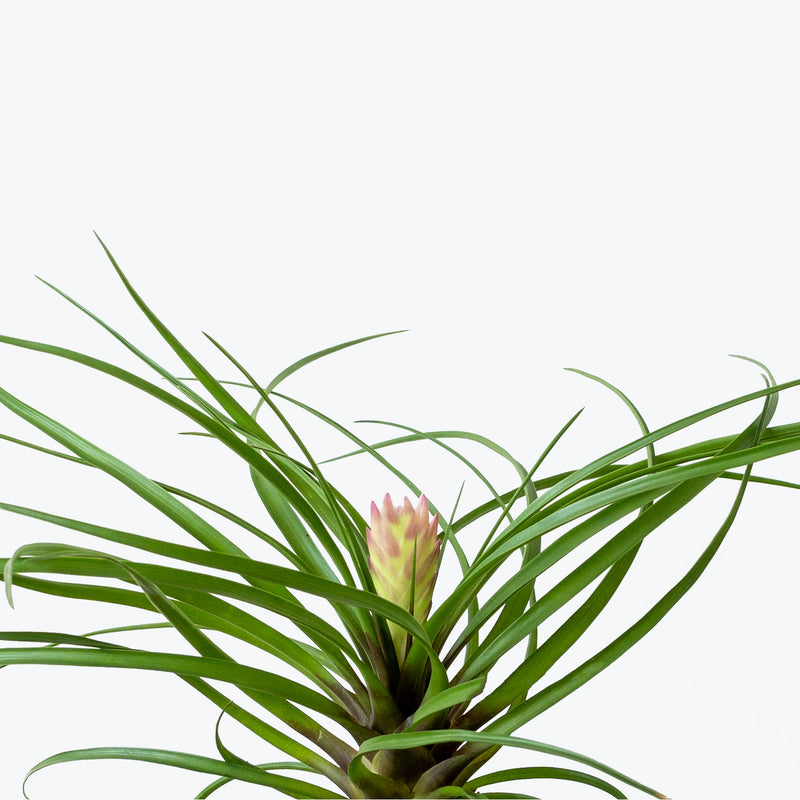
How to care for Tillandsia Cyanea
Tillandsia Cyanea should not be in a position to see the sun directly, although early morning or late evening sun is fine. Filtered sunlight through a sheer curtain is best and most homes are comprised primarily of indirect sunlight. The best spot for them is where they do not see the sun during the majority of the day but still get bright, indirect light.
Tillandsia Cyanea will thrive in bright light, but also can tolerate medium light. A good medium-light place in your home would be in the middle of a room that has a regular size window. They can be placed anywhere between the middle of the room and the window. Remember that plants will grow based on how much light they receive and flowers generally need more light than foliage.
Tillandsia Cyanea likes the soil to be relatively dry before the next watering. That usually takes about 2 weeks in an average home environment. It will vary depending on the time of year, your environment and lighting conditions, but for them, it's always safer to underwater or water when you see signs of lack of water (i.e. droopy, floppy, or soft leaves). Expect to water more often in brighter light and less often in lower light.
Tillandsia Cyanea will do well in average humidity environments but will appreciate a little bit of humidity if provided, give them a mist daily or get a humidifier.
It is best to use rainwater or distilled water Tillandsia Cyanea. The center of a bromeliad is called a tank or cup, and, when watering, fill the cup in the center and don’t allow it to get empty. That being said, don't let that standing water sit longer than a week, as the water will become stagnant and could possibly damage the plant. The flower will generally last for 3-6 months and the main plant won't flower again, producing offsets instead.
You can feel comfortable having Tillandsia Cyanea around your home in the potential case where your pet feels like nibbling on it. However, we typically recommend keeping your pets from eating any of your houseplants..
Learn MoreView PlantTillandsia Melanocrater Air Plant
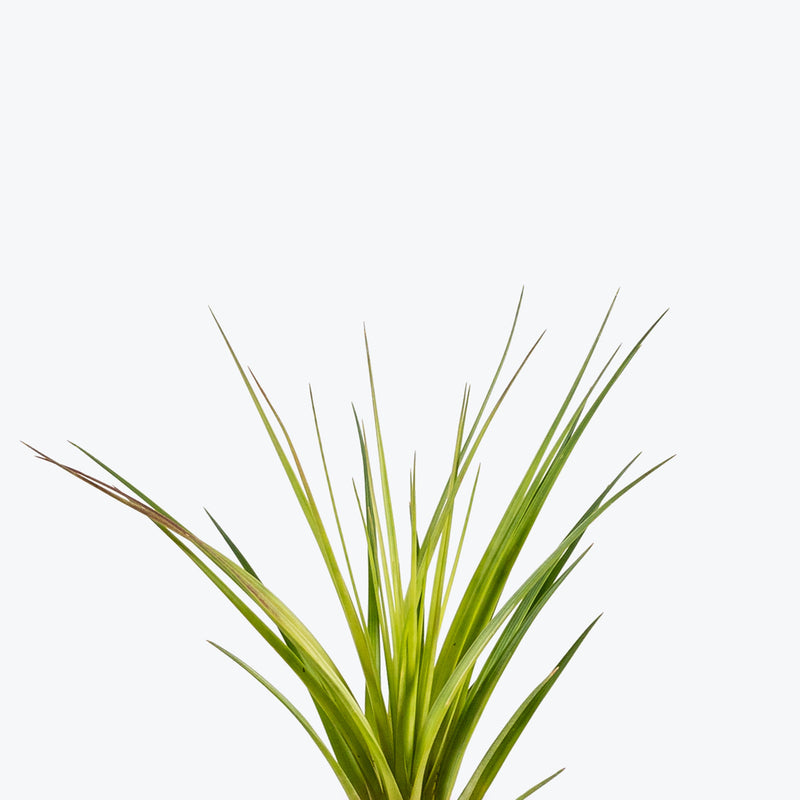
How to care for Tillandsia Melanocrater Air Plant
Tillandsia Melanocrater should not be in a position to see the sun directly, although early morning or late evening sun is fine. Filtered sunlight through a sheer curtain is best and most homes are comprised primarily of indirect sunlight. The best spot for them is where they do not see the sun during the majority of the day but still get bright, indirect light.
Tillandsia Melanocrater will thrive in bright light, but also can tolerate medium light. A good medium-light place in your home would be in the middle of a room that has a regular size window. They can be placed anywhere between the middle of the room and the window. Remember that plants will grow based on how much light they receive.
Soak Tillandsia Melanocrater in a bowl of room temperature water for an hour every week. Shake excess water off afterward and lay your plant upside down on a towel in a bright spot to dry.
Tillandsia Melanocrater will do well in average humidity environments but will appreciate a little bit of humidity if provided, give them a mist daily or get a humidifier.
Provide good air circulation around the Tillandsia Melanocrater Air Plant to promote healthy growth and prevent disease. Fertilize monthly during the growing season with a bromeliad or diluted general-purpose liquid fertilizer. During flowering, reduce watering and fertilization to support the bloom cycle. After flowering, the mother plant will gradually die back as it produces offsets, or "pups," which can be separated and grown as new plants.
You can feel comfortable having Tillandsia Melanocrater around your home in the potential case where your pet feels like nibbling on it. However, we typically recommend keeping your pets from eating any of your houseplants..
Learn MoreView PlantTillandsia Xerographica Air Plant
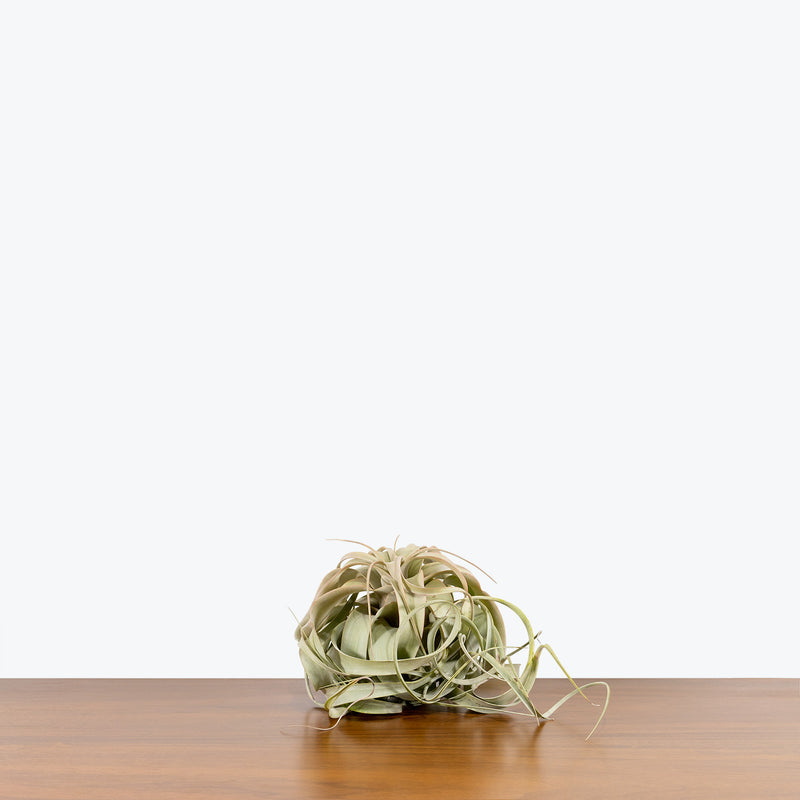
How to care for Tillandsia Xerographica Air Plant
Tillandsia Xerographica should not be in a position to see the sun directly, although early morning or late evening sun is fine. Filtered sunlight through a sheer curtain is best and most homes are comprised primarily of indirect sunlight. The best spot for them is where they do not see the sun during the majority of the day but still get bright, indirect light.
Tillandsia Xerographica will thrive in bright light, but also can tolerate medium light. A good medium-light place in your home would be in the middle of a room that has a regular size window. They can be placed anywhere between the middle of the room and the window. Remember that plants will grow based on how much light they receive.
Soak Tillandsia Xerographica in a bowl of room temperature water for an hour every week. Shake excess water off afterward and lay your plant upside down on a towel in a bright spot to dry.
Tillandsia Xerographica will do well in average humidity environments but will appreciate a little bit of humidity if provided, give them a mist daily or get a humidifier.
Increase humidity with increased light to avoid dry out. Make sure Tillandsia Xerographica are in an area with good air circulation, do not put them in completely enclosed containers. Avoid letting water sit between the leaves for very long periods of time after watering, as this can lead to them rotting at the centre.
You can feel comfortable having Tillandsia Xerographica around your home in the potential case where your pet feels like nibbling on it. However, we typically recommend keeping your pets from eating any of your houseplants..
Learn MoreView PlantTradescantia Bolivian Dwarf
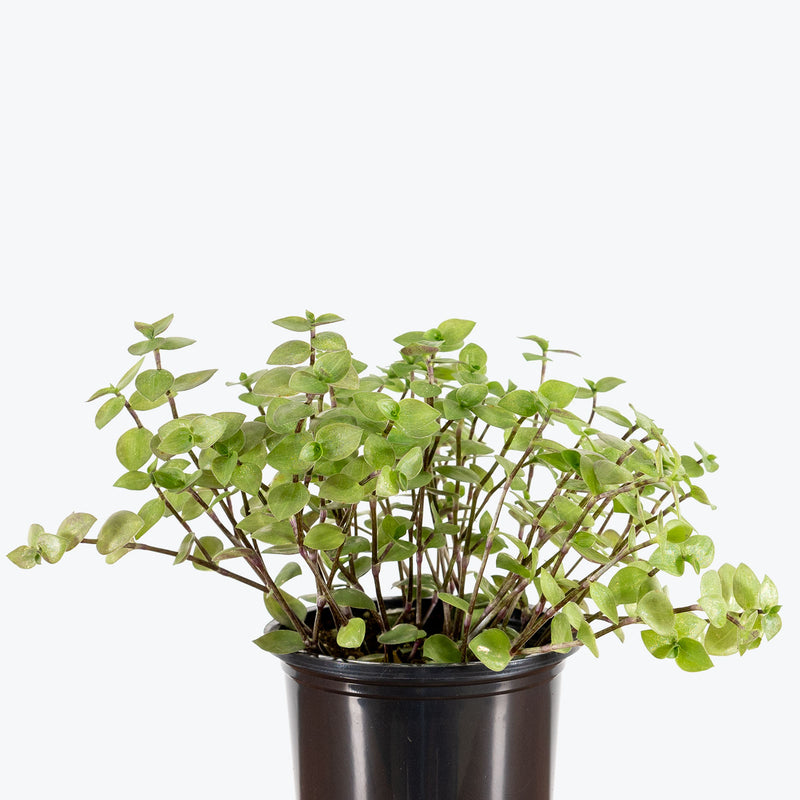
How to care for Tradescantia Bolivian Dwarf
They enjoy some direct sun, but they'll also do well in bright, indirect light. It is best to place this plant somewhere where it will receive some nice morning sun, or a couple hours of afternoon sun, and then indirect light the rest of the day.
They will do best in bright light. A nice bright place inside your home would be on the window sill or a stool that is right next to a window, either with or without blinds, depending on if the plant can handle sun. Remember that plants will grow based on how much light they receive.
They need to be watered when the top half of the soil is dry to the touch. That usually takes about 1 week in an average home environment. It will vary depending on the time of year, your environment and lighting conditions, but it's always safer to underwater or give the soil a check before you water again. Expect to water more often in brighter light and less often in lower light.
They can live in any average home humidity condition and are fairly hardy.
While the turtle vine requires very little maintenance overall, pinching the stem tips will help the turtle vine stay compact. Brighter light helps keep the plant healthy and avoids letting the plant become straggly.
This plant is moderately toxic and can cause some adverse reactions when ingested so it is best to not let your pets eat it, which we advise for all plants in general. The severity of the reaction will depend on how much of the plant is ingested but, if you know your pet typically does not eat your plants, this plant will be suitable for your home..
View PlantTradescantia Fluminensis Quicksilver
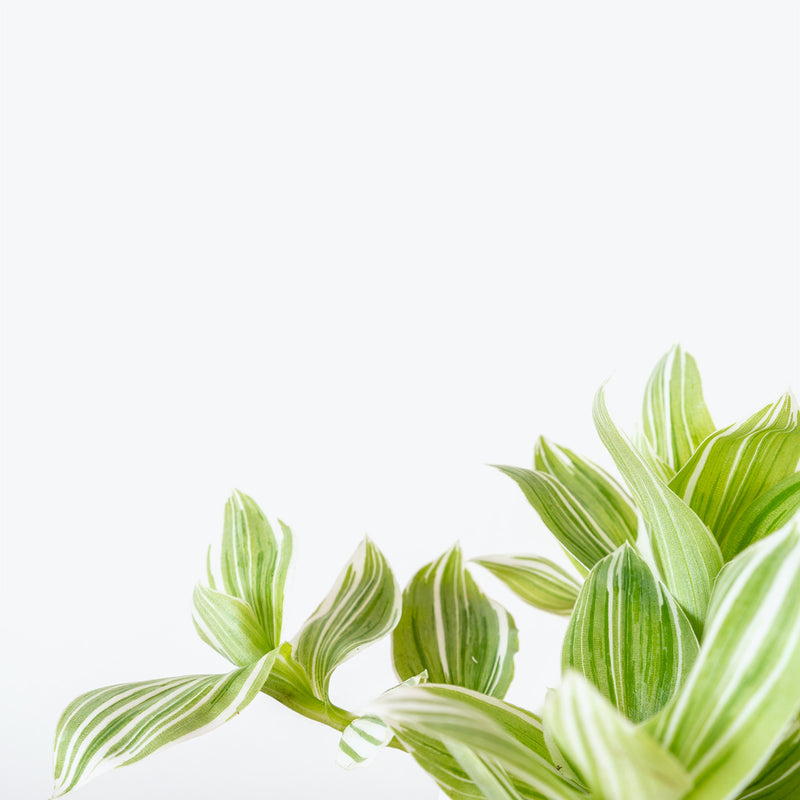
How to care for Tradescantia Fluminensis Quicksilver
Tradescantia Fluminensis Quicksilver enjoys some direct sun, but they'll also do well in bright, indirect light. It is best to place this plant somewhere where it will receive some nice morning sun, or a couple hours of afternoon sun, and then indirect light the rest of the day.
Tradescantia Fluminensis Quicksilver will thrive in medium to bright light, but also can tolerate low light. A good medium-light place in your home would be in the middle of a room that has a regular size window. They can be placed almost anywhere in the room but remember, plants will grow based on how much light they receive.
Tradescantia Fluminensis Quicksilver needs to be watered when the top half of the soil is dry to the touch. That usually takes about 1 week in an average home environment. It will vary depending on the time of year, your environment and lighting conditions, but it's always safer to underwater or give the soil a check before you water again. Expect to water more often in brighter light and less often in lower light.
Tradescantia Fluminensis Quicksilver will do well in average humidity environments but will appreciate a little bit of humidity if provided, give them a mist daily or get a humidifier.
While Tradescantia Fluminensis Quicksilver requires very little maintenance overall, pinching the stem tips will help them stay compact. Brighter light helps keep the plant healthy and avoids letting the plant become straggly.
Tradescantia Fluminensis Quicksilver is moderately toxic and can cause some adverse reactions when ingested so it is best to not let your pets eat it, which we advise for all plants in general. The severity of the reaction will depend on how much of the plant is ingested but, if you know your pet typically does not eat your plants, this plant will be suitable for your home..
View PlantTradescantia Fluminensis Variegata
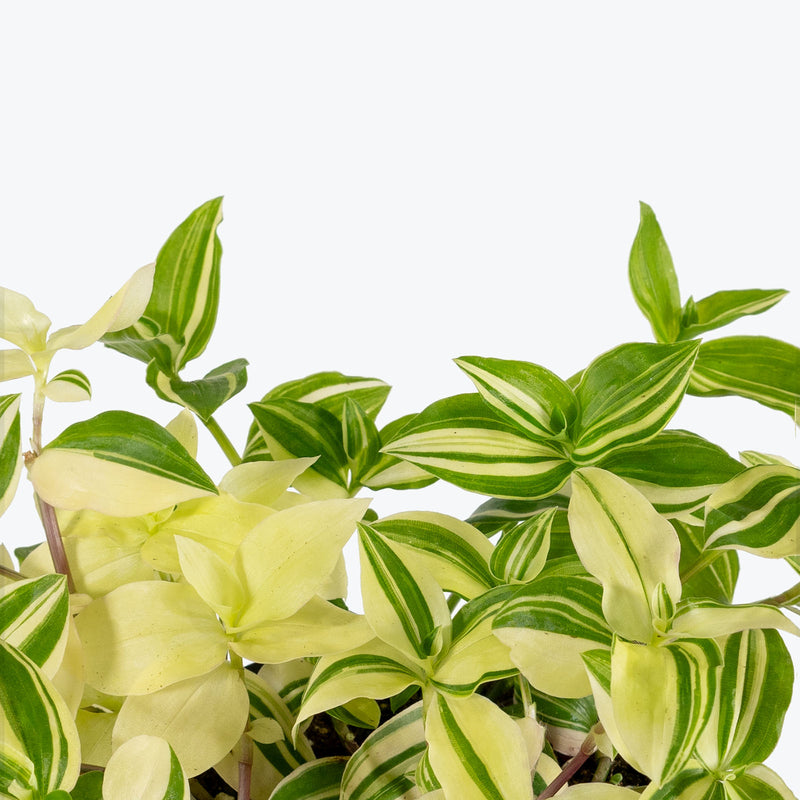
How to care for Tradescantia Fluminensis Variegata
Tradescantia Fluminensis Variegata enjoys some direct sun, but they'll also do well in bright, indirect light. It is best to place this plant somewhere where it will receive some nice morning sun, or a couple hours of afternoon sun, and then indirect light the rest of the day.
Tradescantia Fluminensis Variegata will thrive in medium to bright light, but also can tolerate low light. A good medium-light place in your home would be in the middle of a room that has a regular size window. They can be placed almost anywhere in the room but remember, plants will grow based on how much light they receive.
Tradescantia Fluminensis Variegata needs to be watered when the top half of the soil is dry to the touch. That usually takes about 1 week in an average home environment. It will vary depending on the time of year, your environment and lighting conditions, but it's always safer to underwater or give the soil a check before you water again. Expect to water more often in brighter light and less often in lower light.
Tradescantia Fluminensis Variegata will do well in average humidity environments but will appreciate a little bit of humidity if provided, give them a mist daily or get a humidifier.
Prune Tradescantia Fluminensis Variegata regularly to encourage bushier growth and prevent the stems from becoming too leggy. Regular pruning also gives you the opportunity to propagate new plants from the cuttings. Clean the leaves periodically to remove dust and enhance photosynthesis.
Tradescantia Fluminensis Variegata is moderately toxic and can cause some adverse reactions when ingested so it is best to not let your pets eat it, which we advise for all plants in general. The severity of the reaction will depend on how much of the plant is ingested but, if you know your pet typically does not eat your plants, this plant will be suitable for your home..
View PlantTradescantia Multicolor Discolor
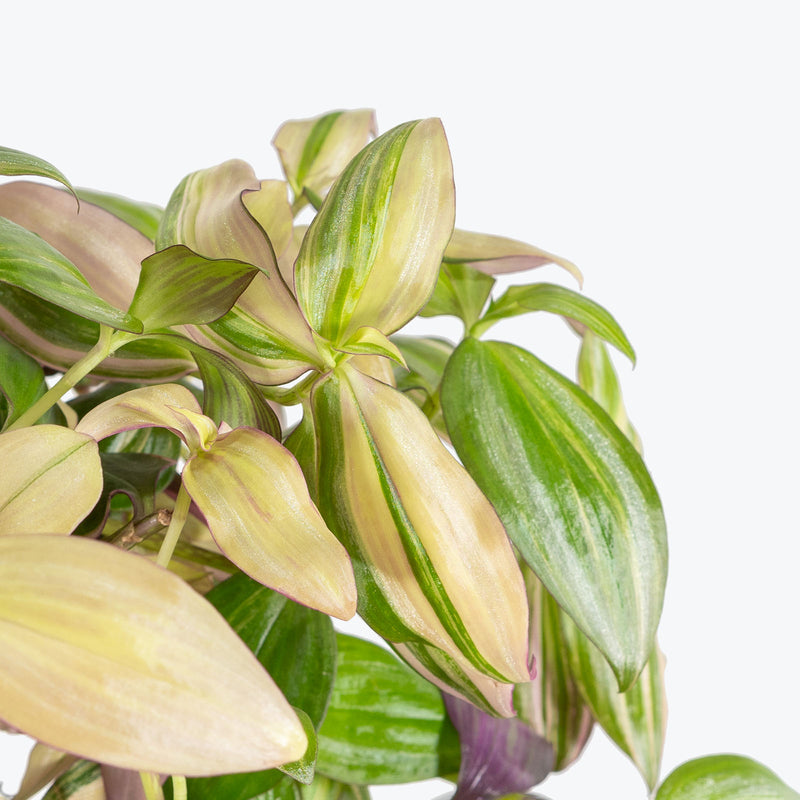
How to care for Tradescantia Multicolor Discolor
Tradescantia Multicolor Discolor should not be in a position to see the sun directly, although early morning or late evening sun is fine. Filtered sunlight through a sheer curtain is best and most homes are comprised primarily of indirect sunlight. The best spot for them is where they do not see the sun during the majority of the day but still get bright, indirect light.
Tradescantia Multicolor Discolor will thrive in bright light, but also can tolerate medium light. A good medium-light place in your home would be in the middle of a room that has a regular size window. They can be placed anywhere between the middle of the room and the window. Remember that plants will grow based on how much light they receive.
Tradescantia Multicolor Discolor needs to be watered when the top half of the soil is dry to the touch. That usually takes about 1 week in an average home environment. It will vary depending on the time of year, your environment and lighting conditions, but it's always safer to underwater or give the soil a check before you water again. Expect to water more often in brighter light and less often in lower light.
Tradescantia Multicolor Discolor can live in any average home humidity condition and are fairly hardy.
Regularly pinch back the stem tips to encourage bushier growth. If Tradescantia Multicolor Discolor becomes too leggy, cut back to rejuvenate and stimulate new growth. The vibrant foliage can be kept dust-free and shiny by gently wiping with a damp cloth.
Tradescantia Multicolor Discolor is moderately toxic and can cause some adverse reactions when ingested so it is best to not let your pets eat it, which we advise for all plants in general. The severity of the reaction will depend on how much of the plant is ingested but, if you know your pet typically does not eat your plants, this plant will be suitable for your home..
View PlantTradescantia Nanouk
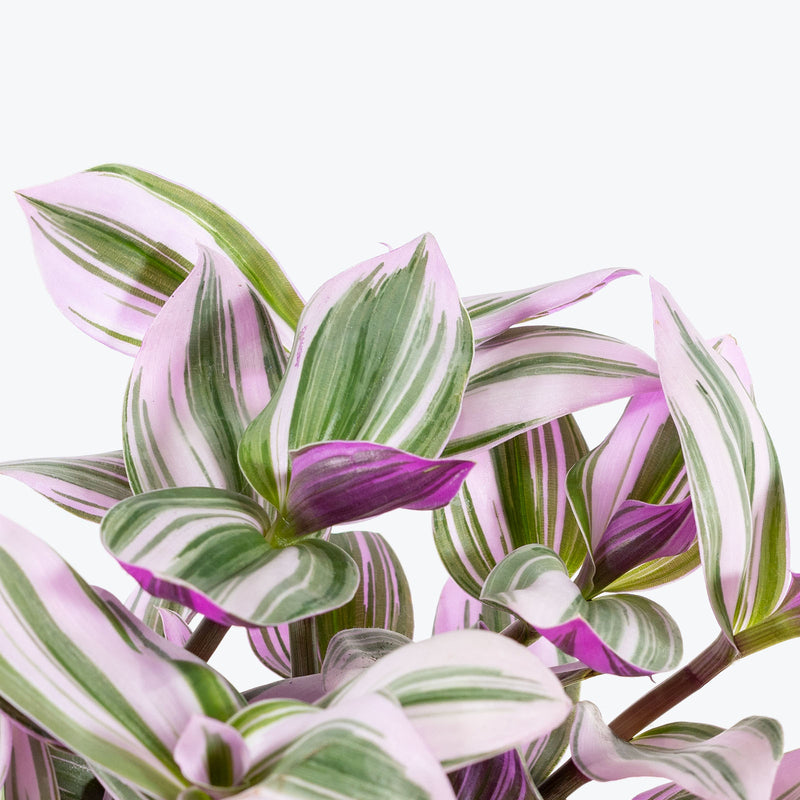
How to care for Tradescantia Nanouk
Tradescantia Nanouk enjoys some direct sun, but they'll also do well in bright, indirect light. It is best to place this plant somewhere where it will receive some nice morning sun, or a couple hours of afternoon sun, and then indirect light the rest of the day.
Tradescantia Nanouk will thrive in bright light, but also can tolerate medium light. A good medium-light place in your home would be in the middle of a room that has a regular size window. They can be placed anywhere between the middle of the room and the window. Remember that plants will grow based on how much light they receive. Brighter light will encourage more vibrant colouring.
Tradescantia Nanouk needs to be watered when the top half of the soil is dry to the touch. That usually takes about 1 week in an average home environment. It will vary depending on the time of year, your environment and lighting conditions, but it's always safer to underwater or give the soil a check before you water again. Expect to water more often in brighter light and less often in lower light.
Tradescantia Nanouk will do well in average humidity environments but will appreciate a little bit of humidity if provided, give them a mist daily or get a humidifier.
Feed monthly with a diluted, balanced liquid fertilizer in spring and summer, while the plant is actively growing. While Tradescantia Nanouk requires very little maintenance overall, pinching the stem tips will help them stay compact. Pruning can encourage a bushier growth pattern and prevent the plant from becoming leggy. Brighter light helps keep the plant healthy and avoids letting the plant become straggly.
Tradescantia Nanouk is moderately toxic and can cause some adverse reactions when ingested so it is best to not let your pets eat it, which we advise for all plants in general. The severity of the reaction will depend on how much of the plant is ingested but, if you know your pet typically does not eat your plants, this plant will be suitable for your home..
View PlantTradescantia Navicularis
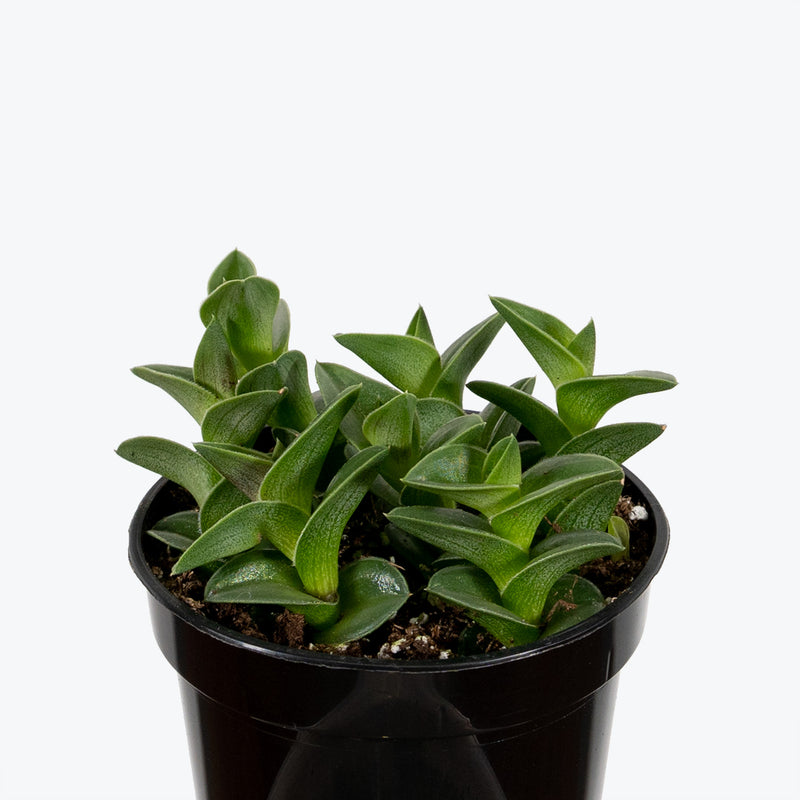
How to care for Tradescantia Navicularis
They enjoy some direct sun, but they'll also do well in bright, indirect light. It is best to place this plant somewhere where it will receive some nice morning sun, or a couple hours of afternoon sun, and then indirect light the rest of the day.
They will thrive in bright light, but also can tolerate medium light. A good medium-light place in your home would be in the middle of a room that has a regular size window. They can be placed anywhere between the middle of the room and the window. Remember that plants will grow based on how much light they receive.
They need to be watered when the top half of the soil is dry to the touch. That usually takes about 1 week in an average home environment. It will vary depending on the time of year, your environment and lighting conditions, but it's always safer to underwater or give the soil a check before you water again. Expect to water more often in brighter light and less often in lower light.
They can live in any average home humidity condition and are fairly hardy.
In order to maintain compact, stacked leaves, rather than very large spaces between each leaf, we recommend keeping your plant in plenty of very bright light - this will also bring out more of the purple colouring! If your plant has gotten too lanky, you can always trim it back to encourage bushier growth and repot these cuttings back into the parent plant.
This plant is moderately toxic and can cause some adverse reactions when ingested so it is best to not let your pets eat it, which we advise for all plants in general. The severity of the reaction will depend on how much of the plant is ingested but, if you know your pet typically does not eat your plants, this plant will be suitable for your home..
View PlantTradescantia Pink Panther
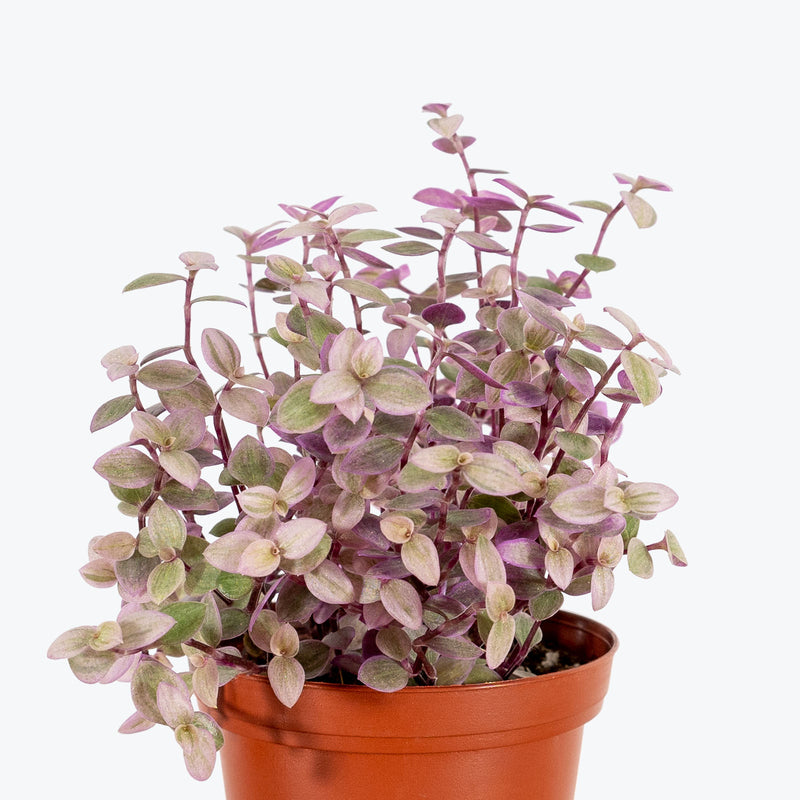
How to care for Tradescantia Pink Panther
They enjoy some direct sun, but they'll also do well in bright, indirect light. It is best to place this plant somewhere where it will receive some nice morning sun, or a couple hours of afternoon sun, and then indirect light the rest of the day.
They will thrive in bright light, but also can tolerate medium light. A good medium-light place in your home would be in the middle of a room that has a regular size window. They can be placed anywhere between the middle of the room and the window. Remember that plants will grow based on how much light they receive.
They need to be watered when the top half of the soil is dry to the touch. That usually takes about 1 week in an average home environment. It will vary depending on the time of year, your environment and lighting conditions, but it's always safer to underwater or give the soil a check before you water again. Expect to water more often in brighter light and less often in lower light.
They will do well in average humidity environments but will appreciate a little bit of humidity if provided, give them a mist daily or get a humidifier.
Feed monthly with a water-soluble houseplant fertilizer in spring and summer, while the plant is actively growing. While Tradescantia require very little maintenance overall, pinching the stem tips will help them stay compact. Brighter light helps keep the plant healthy and avoids letting the plant become straggly.
This plant is moderately toxic and can cause some adverse reactions when ingested so it is best to not let your pets eat it, which we advise for all plants in general. The severity of the reaction will depend on how much of the plant is ingested but, if you know your pet typically does not eat your plants, this plant will be suitable for your home..
View PlantTradescantia Purple Heart
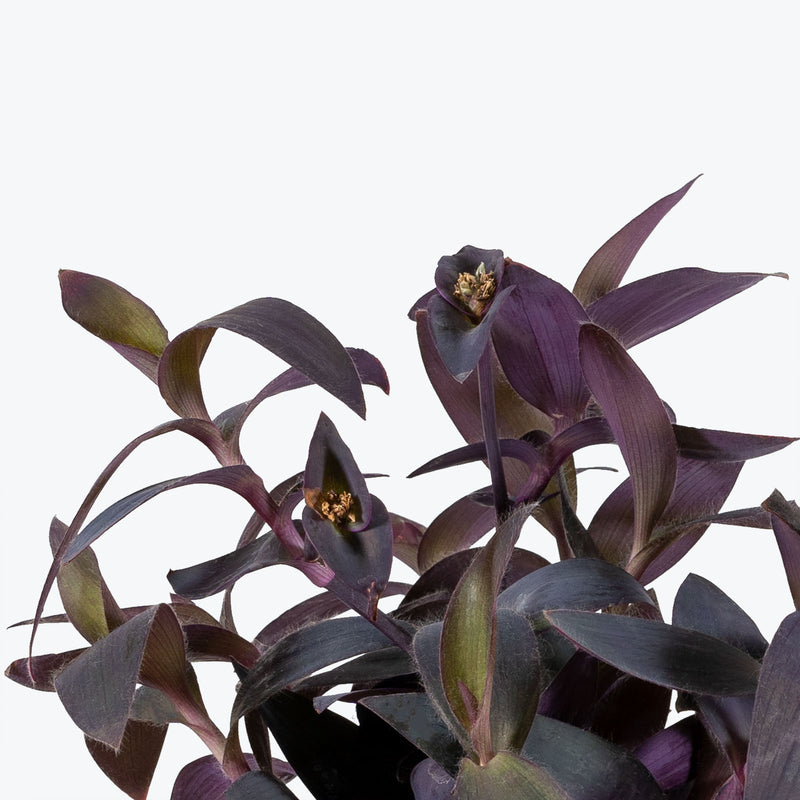
How to care for Tradescantia Purple Heart
They enjoy some direct sun, but they'll also do well in bright, indirect light. It is best to place this plant somewhere where it will receive some nice morning sun, or a couple hours of afternoon sun, and then indirect light the rest of the day.
They will do best in bright light. A nice bright place inside your home would be on the window sill or a stool that is right next to a window, either with or without blinds, depending on if the plant can handle sun. Remember that plants will grow based on how much light they receive.
They need to be watered when the top half of the soil is dry to the touch. That usually takes about 1 week in an average home environment. It will vary depending on the time of year, your environment and lighting conditions, but it's always safer to underwater or give the soil a check before you water again. Expect to water more often in brighter light and less often in lower light.
They will do well in average humidity environments but will appreciate a little bit of humidity if provided, give them a mist daily or get a humidifier.
Tradescantia require very little maintenance overall, but pinching the stem tips will help them stay compact while promoting branching. For this plant, in particular, brighter light helps keep the plant healthy and full, keeping the leaves that striking purple colour, they will fade to green in lower light levels. To propagate, cut 3-inch segments, remove the lower leaves, and place them in a glass jar on a windowsill!
This plant is moderately toxic and can cause some adverse reactions when ingested so it is best to not let your pets eat it, which we advise for all plants in general. The severity of the reaction will depend on how much of the plant is ingested but, if you know your pet typically does not eat your plants, this plant will be suitable for your home..
View PlantTradescantia Sillamontana White Velvet
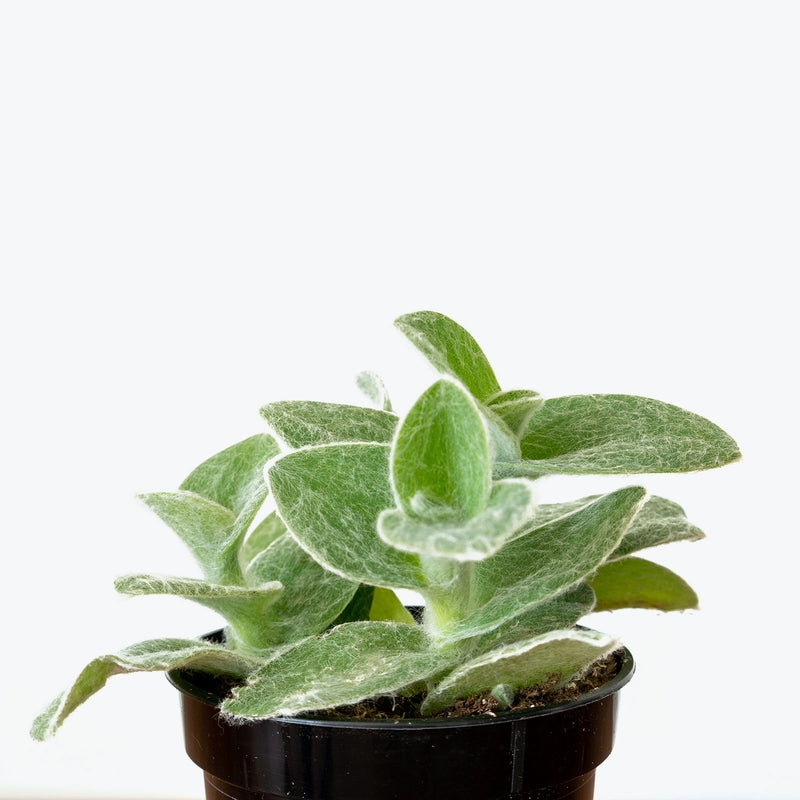
How to care for Tradescantia Sillamontana White Velvet
They enjoy some direct sun, but they'll also do well in bright, indirect light. It is best to place this plant somewhere where it will receive some nice morning sun, or a couple hours of afternoon sun, and then indirect light the rest of the day.
They will do well in medium light but will grow faster with brighter light. A good medium-light place in your home would be in the middle of a room that has a regular size window. Remember that plants will grow based on how much light they receive.
They need to be watered when the top half of the soil is dry to the touch. That usually takes about 1 week in an average home environment. It will vary depending on the time of year, your environment and lighting conditions, but it's always safer to underwater or give the soil a check before you water again. Expect to water more often in brighter light and less often in lower light.
They can live in any average home humidity condition and are fairly hardy.
Feed monthly with a water-soluble houseplant fertilizer in spring and summer, while the plant is actively growing. While Tradescantia require very little maintenance overall, pinching the stem tips will help them stay compact. Brighter light helps keep the plant healthy and avoids letting the plant become straggly.
This plant is moderately toxic and can cause some adverse reactions when ingested so it is best to not let your pets eat it, which we advise for all plants in general. The severity of the reaction will depend on how much of the plant is ingested but, if you know your pet typically does not eat your plants, this plant will be suitable for your home..
View PlantTradescantia Spathacea
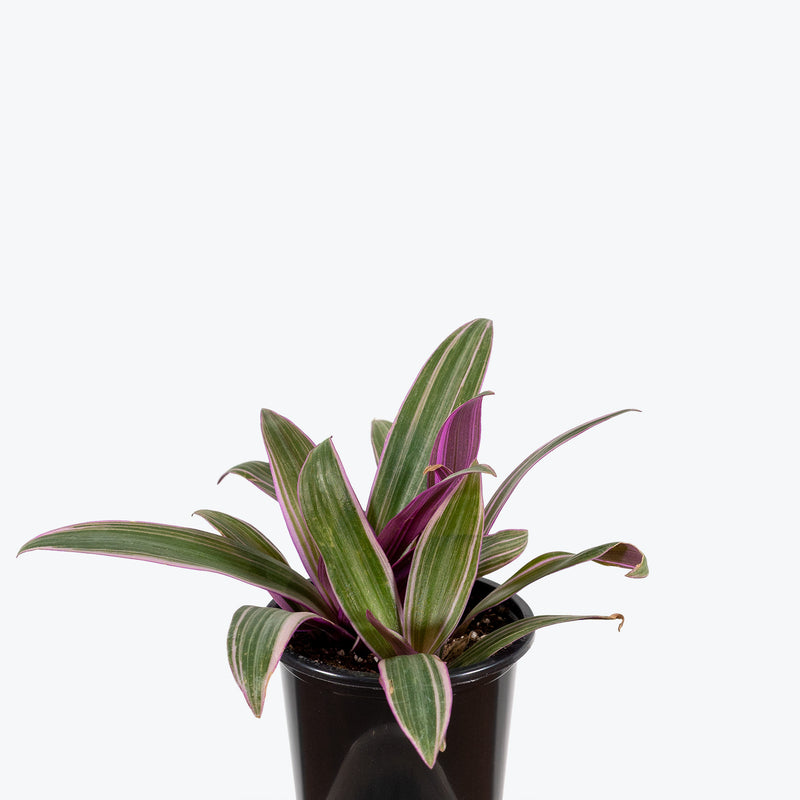
How to care for Tradescantia Spathacea
They should not be in a position to see the sun directly, although early morning or late evening sun is fine. Filtered sunlight through a sheer curtain is best and most homes are comprised primarily of indirect sunlight. The best spot for them is where they do not see the sun during the majority of the day but still get bright, indirect light.
They will do well in medium light but will grow faster and have better colouring with brighter light. A good medium-light place in your home would be in the middle of a room that has a regular size window. Remember that plants will grow based on how much light they receive.
They need to be watered when the top half of the soil is dry to the touch. That usually takes about 1 week in an average home environment. It will vary depending on the time of year, your environment and lighting conditions, but it's always safer to underwater or give the soil a check before you water again. Expect to water more often in brighter light and less often in lower light.
They like a high humidity environment, give them a mist daily or as often as possible. Alternatively, you can put them around a humidifier. Although they won't die if they don't receive enough humidity, their leaves may have some dry, crunchy, or yellow edges.
Feed monthly with a water-soluble houseplant fertilizer in spring and summer, while the plant is actively growing. If your plant isn't flowering, consider giving your plant brighter light! Some morning sun or late afternoon sun will not harm your plant.
This plant is moderately toxic and can cause some adverse reactions when ingested so it is best to not let your pets eat it, which we advise for all plants in general. The severity of the reaction will depend on how much of the plant is ingested but, if you know your pet typically does not eat your plants, this plant will be suitable for your home..
View PlantTradescantia Spathacea Silver
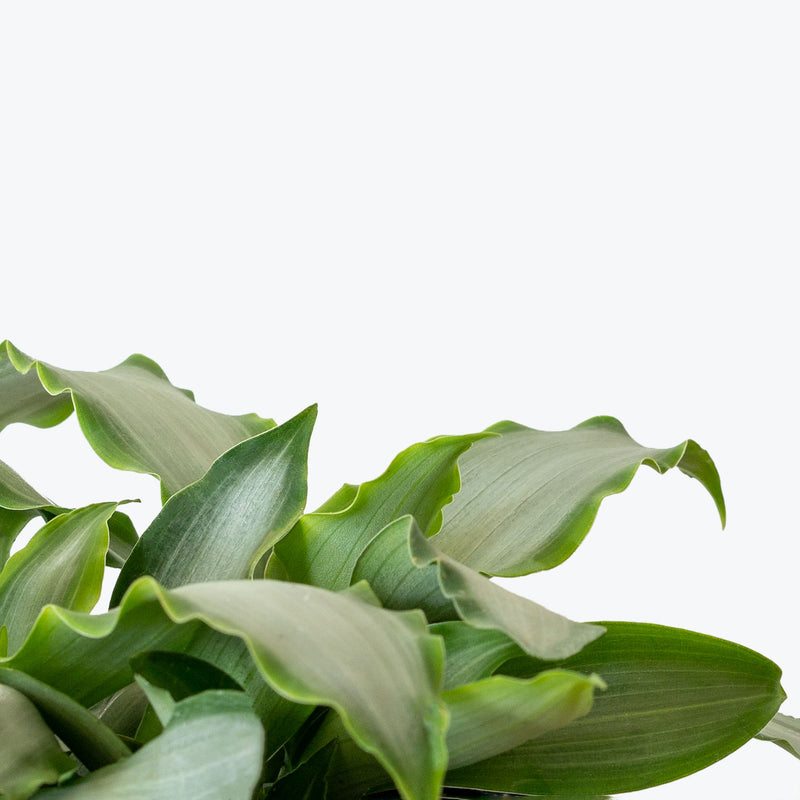
How to care for Tradescantia Spathacea Silver
They should not be in a position to see the sun directly, although early morning or late evening sun is fine. Filtered sunlight through a sheer curtain is best and most homes are comprised primarily of indirect sunlight. The best spot for them is where they do not see the sun during the majority of the day but still get bright, indirect light.
They will thrive in bright light, but also can tolerate medium light. A good medium-light place in your home would be in the middle of a room that has a regular size window. They can be placed anywhere between the middle of the room and the window. Remember that plants will grow based on how much light they receive.
They need to be watered when the top half of the soil is dry to the touch. That usually takes about 1 week in an average home environment. It will vary depending on the time of year, your environment and lighting conditions, but it's always safer to underwater or give the soil a check before you water again. Expect to water more often in brighter light and less often in lower light.
They will do well in average humidity environments but will appreciate a little bit of humidity if provided, give them a mist daily or get a humidifier.
Feed monthly with a water-soluble houseplant fertilizer in spring and summer, while the plant is actively growing. While Tradescantia require very little maintenance overall, pinching the stem tips will help them stay compact. Brighter light helps keep the plant healthy and avoids letting the plant become straggly.
This plant is moderately toxic and can cause some adverse reactions when ingested so it is best to not let your pets eat it, which we advise for all plants in general. The severity of the reaction will depend on how much of the plant is ingested but, if you know your pet typically does not eat your plants, this plant will be suitable for your home..
View PlantTradescantia Spathacea Sitara's Gold
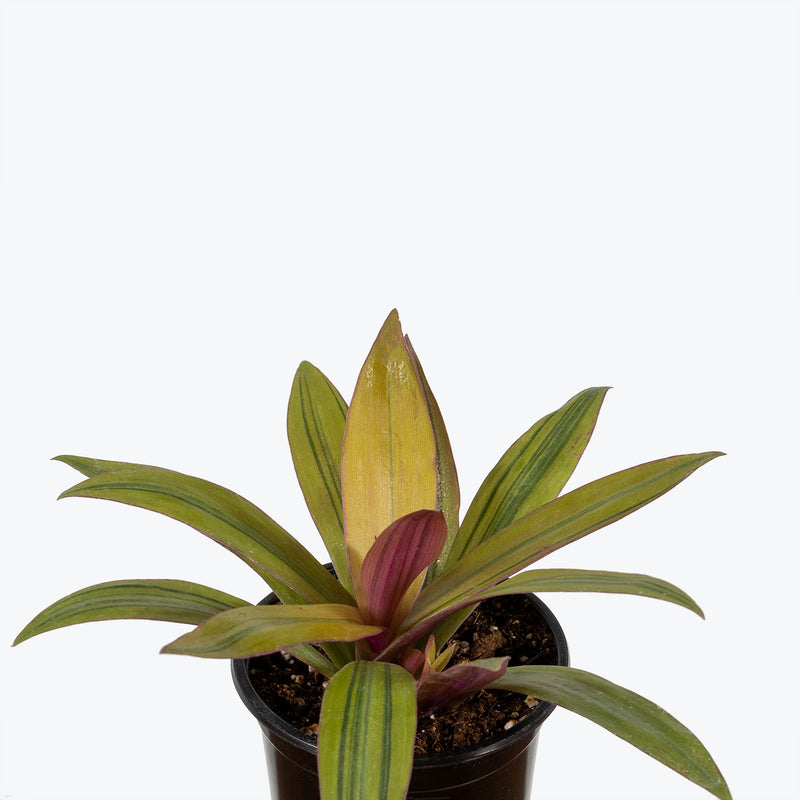
How to care for Tradescantia Spathacea Sitara's Gold
They should not be in a position to see the sun directly, although early morning or late evening sun is fine. Filtered sunlight through a sheer curtain is best and most homes are comprised primarily of indirect sunlight. The best spot for them is where they do not see the sun during the majority of the day but still get bright, indirect light.
They will do well in medium light but will grow faster and have better colouring with brighter light. A good medium-light place in your home would be in the middle of a room that has a regular size window. Remember that plants will grow based on how much light they receive.
They need to be watered when the top half of the soil is dry to the touch. That usually takes about 1 week in an average home environment. It will vary depending on the time of year, your environment and lighting conditions, but it's always safer to underwater or give the soil a check before you water again. Expect to water more often in brighter light and less often in lower light.
They like a high humidity environment, give them a mist daily or as often as possible. Alternatively, you can put them around a humidifier. Although they won't die if they don't receive enough humidity, their leaves may have some dry, crunchy, or yellow edges.
Feed monthly with a water-soluble houseplant fertilizer in spring and summer, while the plant is actively growing. If your plant isn't flowering, consider giving your plant brighter light! Some morning sun or late afternoon sun will not harm your plant.
This plant is moderately toxic and can cause some adverse reactions when ingested so it is best to not let your pets eat it, which we advise for all plants in general. The severity of the reaction will depend on how much of the plant is ingested but, if you know your pet typically does not eat your plants, this plant will be suitable for your home..
View PlantTradescantia Zebrina
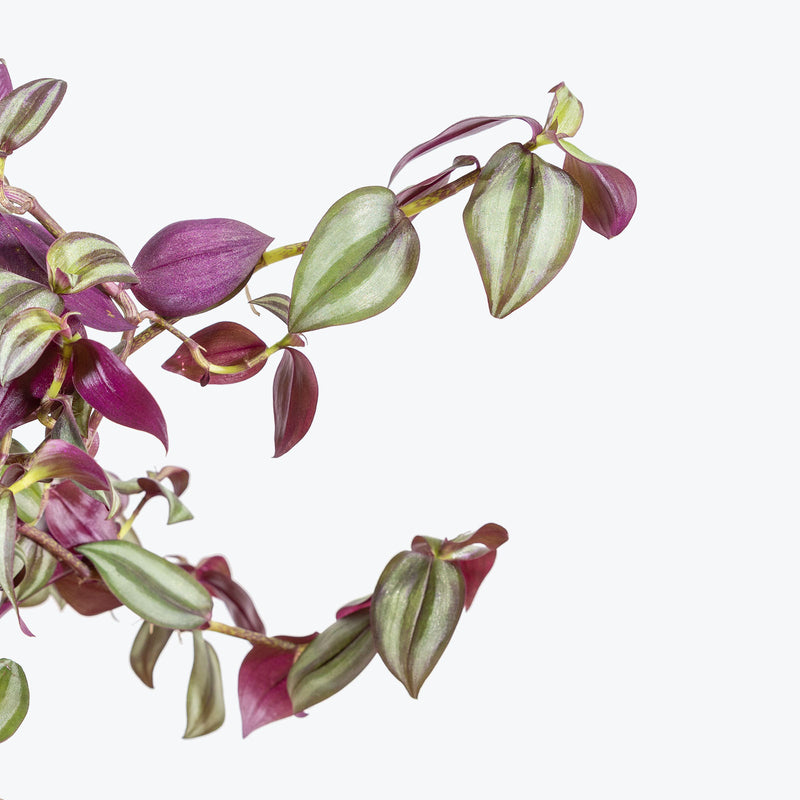
How to care for Tradescantia Zebrina
They enjoy some direct sun, but they'll also do well in bright, indirect light. It is best to place this plant somewhere where it will receive some nice morning sun, or a couple hours of afternoon sun, and then indirect light the rest of the day.
They will do well in medium light but will grow faster with brighter light. A good medium-light place in your home would be in the middle of a room that has a regular size window. Remember that plants will grow based on how much light they receive.
They need to be watered when the top half of the soil is dry to the touch. That usually takes about 1 week in an average home environment. It will vary depending on the time of year, your environment and lighting conditions, but it's always safer to underwater or give the soil a check before you water again. Expect to water more often in brighter light and less often in lower light.
They can live in any average home humidity condition and are fairly hardy.
Tradescantia require very little maintenance overall, but pinching the stem tips will help them stay compact while promoting branching. For this plant, in particular, brighter light helps keep the plant healthy and full, keeping the leaves that striking purple colour, they will fade to green in lower light levels. To propagate, cut 3-inch segments, remove the lower leaves, and place them in a glass jar on a windowsill!
This plant is moderately toxic and can cause some adverse reactions when ingested so it is best to not let your pets eat it, which we advise for all plants in general. The severity of the reaction will depend on how much of the plant is ingested but, if you know your pet typically does not eat your plants, this plant will be suitable for your home..
View PlantTradescantia Zebrina Quadricolor
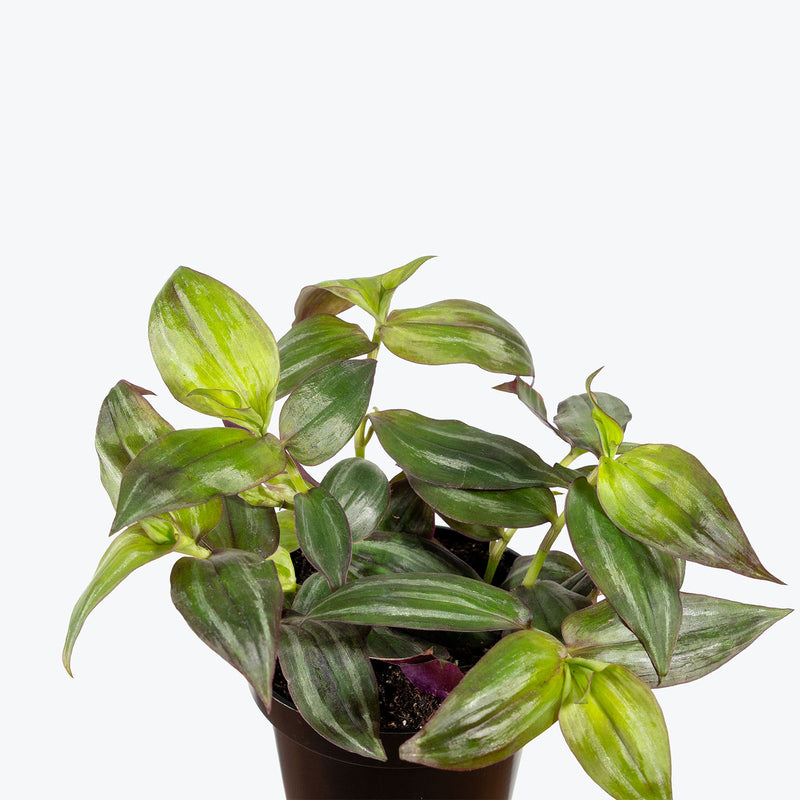
How to care for Tradescantia Zebrina Quadricolor
Tradescantia Zebrina Quadricolor enjoys some direct sun, but they'll also do well in bright, indirect light. It is best to place this plant somewhere where it will receive some nice morning sun, or a couple hours of afternoon sun, and then indirect light the rest of the day.
Tradescantia Zebrina Quadricolor will thrive in medium to bright light, but also can tolerate low light. A good medium-light place in your home would be in the middle of a room that has a regular size window. They can be placed almost anywhere in the room but remember, plants will grow based on how much light they receive.
Tradescantia Zebrina Quadricolor needs to be watered when the top half of the soil is dry to the touch. That usually takes about 1 week in an average home environment. It will vary depending on the time of year, your environment and lighting conditions, but it's always safer to underwater or give the soil a check before you water again. Expect to water more often in brighter light and less often in lower light.
Tradescantia Zebrina Quadricolor will do well in average humidity environments but will appreciate a little bit of humidity if provided, give them a mist daily or get a humidifier.
Pinch back Tradescantia Zebrina Quadricolor regularly to encourage fuller growth and prevent legginess. Tradescantia is fast-growing and benefits from periodic trimming and re-rooting cuttings to refresh its appearance. Fertilize lightly every 4–6 weeks in spring and summer for best colour.
Tradescantia Zebrina Quadricolor is moderately toxic and can cause some adverse reactions when ingested so it is best to not let your pets eat it, which we advise for all plants in general. The severity of the reaction will depend on how much of the plant is ingested but, if you know your pet typically does not eat your plants, this plant will be suitable for your home..
View PlantTrending Succulent Mystery Box
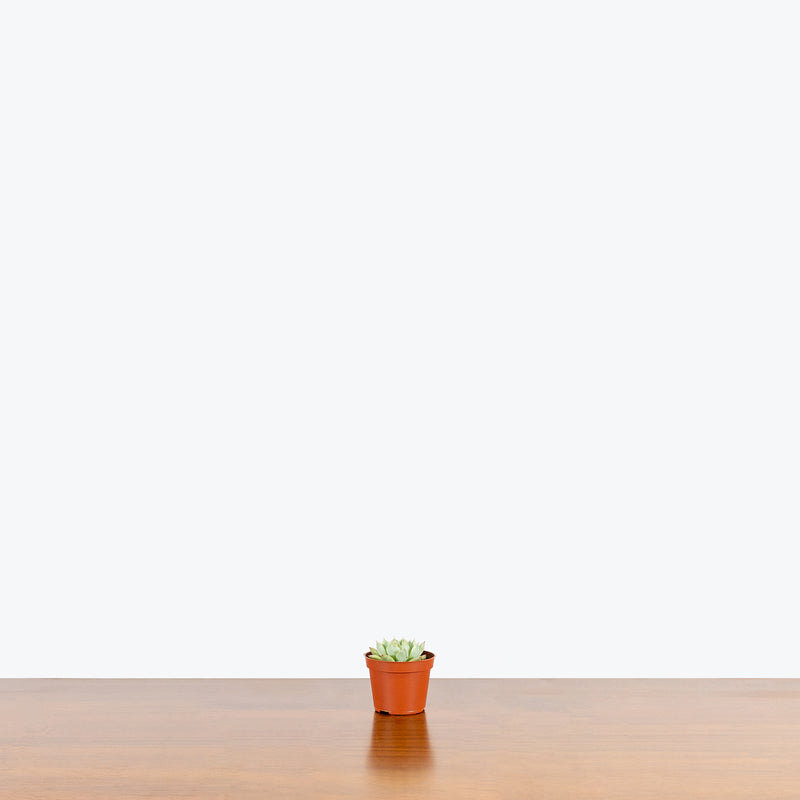
How to care for Trending Succulent Mystery Box
They enjoy some direct sun, but they'll also do well in bright, indirect light. It is best to place this plant somewhere where it will receive some nice morning sun, or a couple hours of afternoon sun, and then indirect light the rest of the day.
They will do best in bright light. A nice bright place inside your home would be on the window sill or a stool that is right next to a window, either with or without blinds, depending on if the plant can handle sun. Remember that plants will grow based on how much light they receive.
They like the soil to be completely dry before the next watering. That usually takes about 4 weeks in an average home environment. It will vary depending on the time of year, your environment and lighting conditions, but for them, it's always safer to underwater or water when you see signs of lack of water (i.e. wrinkly or soft leaves).
Their humidity requirement is low, so do not mist them or put them in an enclosed terrarium.
As with all succulents, overwatering is sure to be fatal, so err on the side of too dry rather than too wet, never letting it sit in water. If you water from beneath by letting the plant sit in a saucer of water, make sure to pour off any excess water after about 15 minutes. If you want compact and colourful growth, keep the plant in direct, high light. If you ever see them grow really tall, that usually means they had too much water or not enough sun.
This plant is moderately toxic and can cause some adverse reactions when ingested so it is best to not let your pets eat it, which we advise for all plants in general. The severity of the reaction will depend on how much of the plant is ingested but, if you know your pet typically does not eat your plants, this plant will be suitable for your home..
Learn MoreView PlantTriple Lucky Bamboo

How to care for Triple Lucky Bamboo
Triple Lucky Bamboo should not be in a position to see the sun directly, although early morning or late evening sun is fine. Filtered sunlight through a sheer curtain is best and most homes are comprised primarily of indirect sunlight. The best spot for them is where they do not see the sun during the majority of the day but still get bright, indirect light.
Triple Lucky Bamboo will do well in medium light but will grow faster with brighter light. A good medium-light place in your home would be in the middle of a room that has a regular size window. Remember that plants will grow based on how much light they receive.
Triple Lucky Bamboo needs to be watered when the top half of the soil is dry to the touch. That usually takes about 1 week in an average home environment. It will vary depending on the time of year, your environment and lighting conditions, but it's always safer to underwater or give the soil a check before you water again.
Triple Lucky Bamboo will do well in average humidity environments but will appreciate a little bit of humidity if provided, give them a mist daily or get a humidifier.
Avoid allowing the soil to dry completely. Be sure to water slowly near the base of the plant as Triple Lucky Bamboo has shallow roots. Use a balanced liquid fertilizer sparingly every few months during the growing season is sufficient. Keep an eye out for pests like spider mites, especially under dry conditions.
Triple Lucky Bamboo is moderately toxic and can cause some adverse reactions when ingested so it is best to not let your pets eat it, which we advise for all plants in general. The severity of the reaction will depend on how much of the plant is ingested but, if you know your pet typically does not eat your plants, this plant will be suitable for your home..
View Plant



